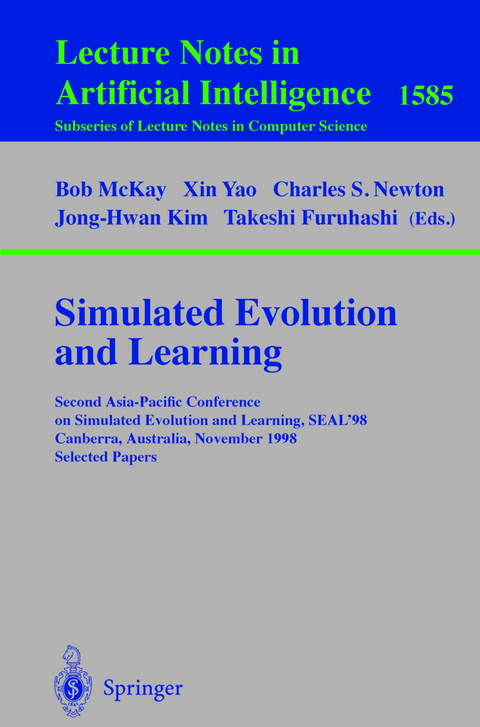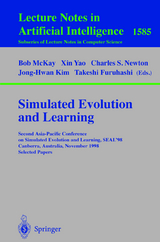Simulated Evolution and Learning
Springer Berlin (Verlag)
978-3-540-65907-5 (ISBN)
Natural Computation.- Multiple Lagrange Multiplier Method for Constrained Evolutionary Optimization.- Robust Evolution Strategies.- Hybrid Genetic Algorithm for Solving the p-Median Problem.- Correction of Reflection Lines Using Genetic Algorithms.- Adaptation under Changing Environments with Various Rates of Inheritance of Acquired Characters.- Dynamic Control of Adaptive Parameters in Evolutionary Programming.- Information Operator Scheduling by Genetic Algorithms.- Solving Radial Topology Constrained Problems with Evolutionary Algorithms.- Automating Space Allocation in Higher Education.- Application of Genetic Algorithm and k-Nearest Neighbour Method in Medical Fraud Detection.- Evolution of Reference Sets in Nearest Neighbor Classification.- Investigation of a Cellular Genetic Algorithm that Mimics Landscape Ecology.- Quantifying Neighborhood Preservation: Joint Properties of Evolutionary and Unsupervised Neural Learning.- Neural Networks and Evolutionary Algorithms for the Prediction of Thermodynamic Properties for Chemical Engineering.- Evolving FPGA Based Cellular Automata.- Asynchronous Island Parallel GA Using Multiform Subpopulations.- Multiple Sequence Alignment Using Parallel Genetic Algorithms.- Evolving Logic Programs to Classify Chess-Endgame Positions.- Genetic Programming with Active Data Selection.- Evolutionary Programming-Based Uni-vector Field Method for Fast Mobile Robot Navigation.- Evolution with Learning Adaptive Functions.- Modelling Plant Breeding Programs as Search Strategies on a Complex Response Surface.- Generating Equations with Genetic Programming for Control of a Movable Inverted Pendulum.- A Hybrid Tabu Search Algorithm for the Nurse Rostering Problem.- Reinforcement Learning: Past, Present and Future.- A Reinforcement Learning with Condition Reduced Fuzz Rules.- Generality and Conciseness of Submodels in Hierarchical Fuzzy Modeling.- Using Evolutionary Programming to Optimize the Allocation of Surveillance Assets.- Applying the Evolutionary Neural Networks with Genetic Algorithms to Control a Rolling Inverted Pendulum.- Evolving Cooperative Actions Among Heterogeneous Agents by an Evolutionary Programming Method.- Cooperative Works for Welfare Agent Robot and Human Using Chaotic Evolutionary Computation.- Evolutionary Computation for Intelligent Agents Based on Chaotic Retrieval and Soft DNA.- A Study of Bayesian Clustering of a Document Set Based on GA.- An Evolutionary Approach in Quantitative Spectroscopy.- Evolutionary Recognition of Features from CAD Data.- Modeling Strategies as Generous and Greedy in Prisoner's Dilemma Like Games.- Using Genetic Algorithms to Simulate the Evolution of an Oligopoly Game.- An Evolutionary Study on Cooperation in N-person Iterated Prisoner's Dilemma Game.- Simulating a N-person Multi-stage Game for Making a State.- Learning from Linguistic Rules and Rule Extraction for Function Approximation by Neural Networks.- Can a Niching Method Locate Multiple Attractors Embedded in the Hopfield Network?.- Time Series Prediction by Using Negatively Correlated Neural Networks.- Animating the Evolution Process of Genetic Algorithms.- Analysis on the Island Model Parallel Genetic Algorithms for the Genetic Drifts.- A Paradox of Neural Encoders and Decoders or Why Don't We Talk Backwards?.- Continuous Optimization Using Elite Genetic Algorithms With Adaptive Mutations.- Evolutionary Systems Applied to the Synthesis of a CPU Controller.- Novel Models in Evolutionary Designing.- Co-evolution, Determinism and Robustness.- Co-operative Evolution of a Neural Classifier andFeature Subset.- Optimal Power Flow Method Using Evolutionary Programming.- Grammatical Development of Evolutionary Modular Neural Networks.- Hybridized Neural Network and Genetic Algorithms for Solving Nonlinear Integer Programming Problem.- Evolution of Gene Coordination Networks.- Adaptive Simulation: An Implementation Framework.- A Model of Mutual Associative Memory for Simulations of Evolution and Learning.- The Application of Cellular Automata to the Consumer's Theory: Simulating a Duopolistic Market.- Object-Oriented Genetic Algorithm Based Artificial Neural Network for Load Forecasting.
| Erscheint lt. Verlag | 26.5.1999 |
|---|---|
| Reihe/Serie | Lecture Notes in Artificial Intelligence | Lecture Notes in Computer Science |
| Zusatzinfo | XIV, 478 p. |
| Verlagsort | Berlin |
| Sprache | englisch |
| Maße | 155 x 235 mm |
| Gewicht | 688 g |
| Themenwelt | Informatik ► Software Entwicklung ► User Interfaces (HCI) |
| Informatik ► Theorie / Studium ► Künstliche Intelligenz / Robotik | |
| Schlagworte | Adaptation • Agent Systems • Algorithmic Learning • Automata • classification • Computer-Aided Design (CAD) • Evolutionäre Algorithmen • evolutionary algorithm • Hardcover, Softcover / Informatik, EDV/Informatik • HC/Informatik, EDV/Informatik • Modeling • Navigation • Optimization • reflection • Reinforcement Learning • robot • simulated evolution • Topology |
| ISBN-10 | 3-540-65907-2 / 3540659072 |
| ISBN-13 | 978-3-540-65907-5 / 9783540659075 |
| Zustand | Neuware |
| Haben Sie eine Frage zum Produkt? |
aus dem Bereich




